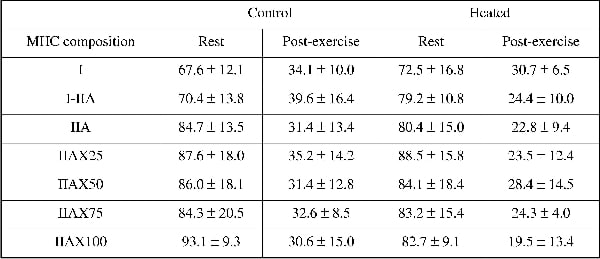We have previously shown that the increased power output observed after passive elevation of muscle temperature (Tm) occurs due to a greater rate of anaerobic ATP turnover (Gray et al. 2006). We also hypothesised that this increase in power was due to a greater contribution to power generation from type IIA fibres. The aim of the present study was to investigate this by examining PCr utilisation in single muscle fibres, characterised according to their myosin heavy chain (MHC) content. Six male volunteers (age 25 ± 6 years, height 1.82 ± 0.07 m, mass 77 ± 11 kg; mean ± S.D.) performed a 6 s maximal sprint on a cycle ergometer under control (C, Tm= 34.3 ± 0.6°C) and heated (H, Tm= 37.3 ± 0.2°C) conditions as described previously (Gray et al. 2006). Biopsies were taken from the vastus lateralis prior to and immediately after exercise. Freeze-dried single muscle fibres were dissected and analysed for MHC content (SDS-PAGE) and PCr concentration (Wibom et al. 1991). Fibres were classified as: type I, I-IIA, IIA, IIAX25 (fibres containing 1-25% type IIX MHC isoform), IIAX50 (26-50% IIX), IIAX75 (51-75% IIX) and IIAX100 (76-100% IIX). Statistical analyses were performed using two-way repeated measures ANOVA and Bonferroni corrected paired t-tests where appropriate. The warming increased maximal power output by 258 ± 110 W compared to C. Resting PCr content was not affected by the elevation of muscle temperature in any fibre group. There was a 9% greater (P<0.05) decrease in PCr content, after exercise, in MHC IIA fibres in H (ΔPCr = 57.6 ± 11.6 mmol kg -1 (dm)) compared to C (ΔPCr = 53.3 ± 13.5 mmol kg -1 (dm)). We have demonstrated a greater PCr utilisation in single fibres containing 100% MHC IIA during the development of maximal power output when muscle temperature is elevated.
University College London 2006 (2006) Proc Physiol Soc 3, C40
Oral Communications: Greater PCr utilisation in single human type IIA muscle fibres during the development of maximal power output at higher muscle temperatures
Stuart R Gray1, Karin Söderlund2, Richard Ferguson1
1. Applied Physiology, University of Strathclyde, Glasgow, United Kingdom. 2. Stockholm University College of P.E. and Sports, GIH, Stockholm, Sweden. 3. Physiology and Pharmacology, Karolinska Institutet, Stockholm, Sweden.
View other abstracts by:
Table 1. PCr concentration in MHC characterised single muscle fibres before and after a 6 s sprint under control and heated muscle temperature conditions
Where applicable, experiments conform with Society ethical requirements.

